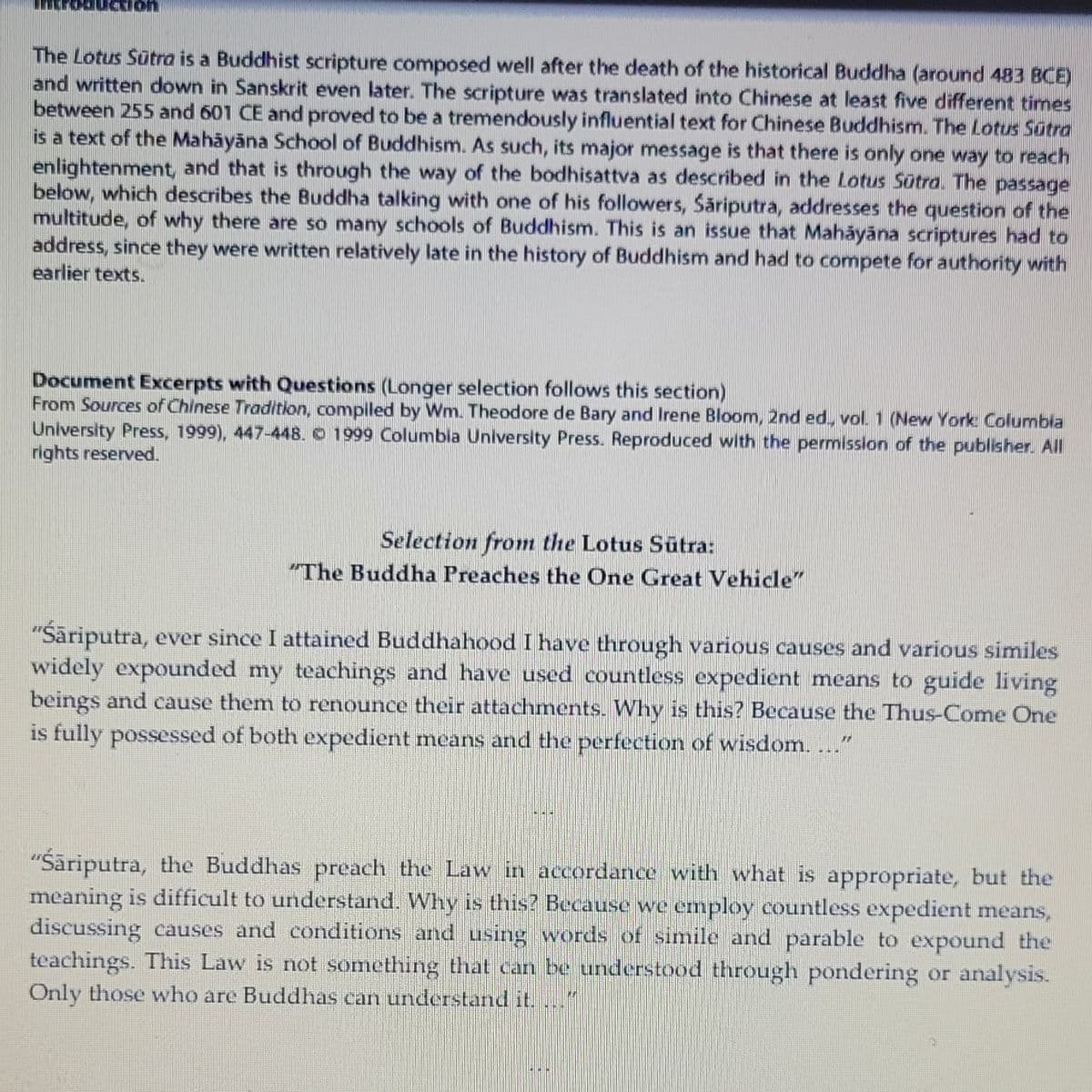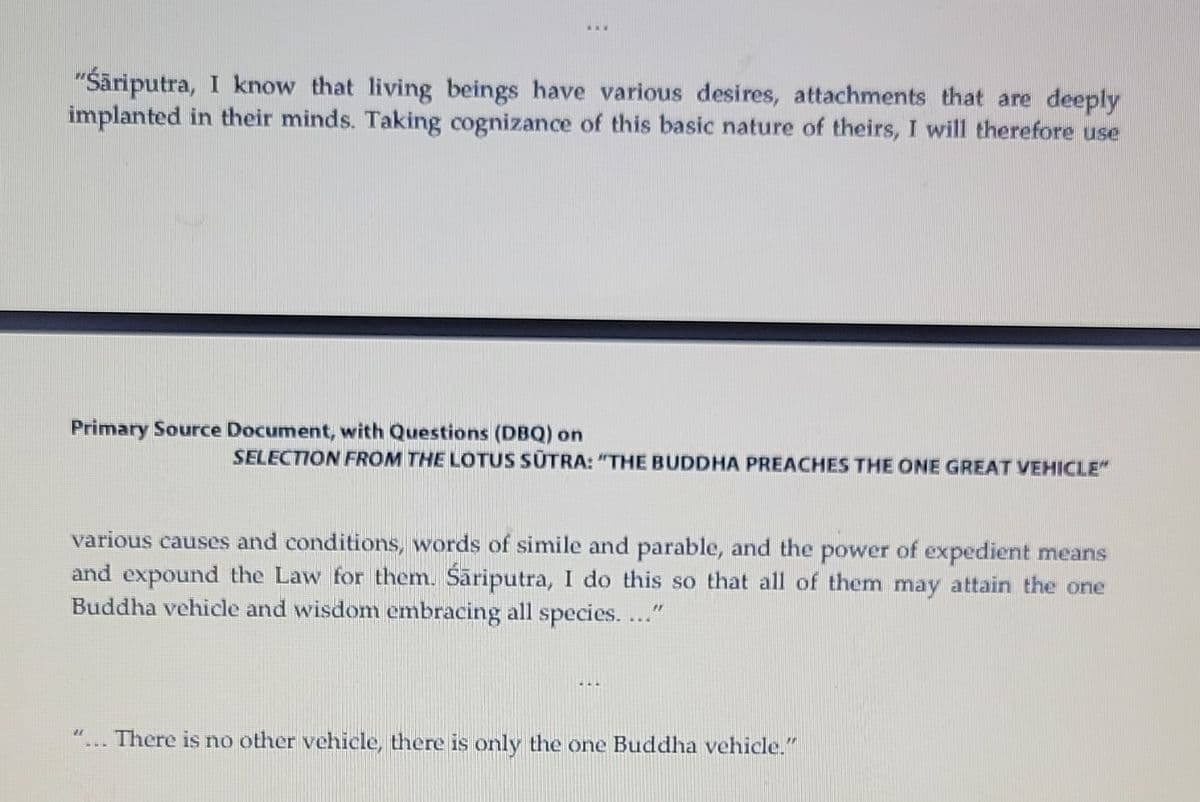Please read the Lotus Sutra and respond to the questions at the end of the first short selection (these questions are pasted below). Each response should be between 1-3 sentences and should come only from the primary source itself. In these excerpts, how does the Buddha explain the existence of various Buddhist teachings? As the Lotus Sūtra describes it, is there one or are there many truths? Is the understanding of truth articulated in these excerpts something that would contribute to a democratic and egalitarian religion or to an elitist religious hierarchy?
Please read the Lotus Sutra and respond to the questions at the end of the first short selection (these questions are pasted below). Each response should be between 1-3 sentences and should come only from the primary source itself. In these excerpts, how does the Buddha explain the existence of various Buddhist teachings? As the Lotus Sūtra describes it, is there one or are there many truths? Is the understanding of truth articulated in these excerpts something that would contribute to a democratic and egalitarian religion or to an elitist religious hierarchy?
Related questions
Question
Please read the Lotus Sutra and respond to the questions at the end of the first short selection (these questions are pasted below). Each response should be between 1-3 sentences and should come only from the primary source itself.
- In these excerpts, how does the Buddha explain the existence of various Buddhist teachings?
- As the Lotus Sūtra describes it, is there one or are there many truths?
- Is the understanding of truth articulated in these excerpts something that would contribute to a democratic and egalitarian religion or to an elitist religious hierarchy?
- How do later texts in other philosophical or religious traditions deal with alternative texts that claim authority? Do they use techniques similar to the doctrine of “expedient means”? Or do different philosophical or religious traditions use other strategies to establish the ultimate authority of a particular text or teaching?

Transcribed Image Text:Non
The Lotus Sūtra is a Buddhist scripture composed well after the death of the historical Buddha (around 483 BCE)
and written down in Sanskrit even later. The scripture was translated into Chinese at least five different times
between 255 and 601 CE and proved to be a tremendously influential text for Chinese Buddhism. The Lotus Sūtra
is a text of the Mahāyāna School of Buddhism. As such, its major message is that there is only one way to reach
enlightenment, and that is through the way of the bodhisattva as described in the Lotus Sūtra. The passage
below, which describes the Buddha talking with one of his followers, Säriputra, addresses the question of the
multitude, of why there are so many schools of Buddhism. This is an issue that Mahāyāna scriptures had to
address, since they were written relatively late in the history of Buddhism and had to compete for authority with
earlier texts.
Document Excerpts with Questions (Longer selection follows this section)
From Sources of Chinese Tradition, compiled by Wm. Theodore de Bary and Irene Bloom, 2nd ed., vol. 1 (New York Columbia
University Press, 1999), 447-448. © 1999 Columbia University Press. Reproduced with the permission of the publisher. All
rights reserved.
Selection from the Lotus Sutra:
"The Buddha Preaches the One Great Vehicle"
"Śāriputra, ever since I attained Buddhahood I have through various causes and various similes
widely expounded my teachings and have used countless expedient means to guide living
beings and cause them to renounce their attachments. Why is this? Because the Thus-Come One
is fully possessed of both expedient means and the perfection of wisdom. ..."
DIGE
"Śäriputra, the Buddhas preach the Law in accordance with what is appropriate, but the
meaning is difficult to understand. Why is this? Because we employ countless expedient means,
discussing causes and conditions and using words of simile and parable to expound the
teachings. This Law is not something that can be understood through pondering or analysis.
Only those who are Buddhas can understand it.

Transcribed Image Text:www
"Śäriputra, I know that living beings have various desires, attachments that are deeply
implanted in their minds. Taking cognizance of this basic nature of theirs, I will therefore use
Primary Source Document, with Questions (DBQ) on
SELECTION FROM THE LOTUS SUTRA: "THE BUDDHA PREACHES THE ONE GREAT VEHICLE"
various causes and conditions, words of simile and parable, and the power of expedient means
and expound the Law for them. Śäriputra, I do this so that all of them may attain the one
Buddha vehicle and wisdom embracing all species. ..."
***
"... There is no other vehicle, there is only the one Buddha vehicle."
Expert Solution
This question has been solved!
Explore an expertly crafted, step-by-step solution for a thorough understanding of key concepts.
This is a popular solution!
Trending now
This is a popular solution!
Step by step
Solved in 4 steps
